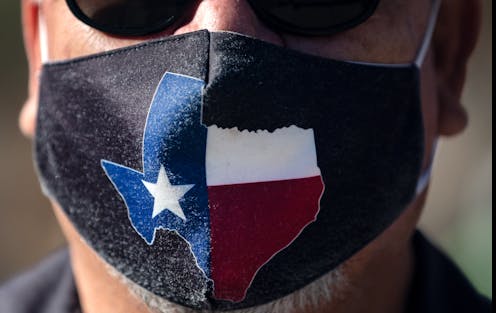States drop COVID-19 mask mandates but still urge people to wear them – which message will people fo
The COVID-19 case spike in the summer of 2020 and the history of seat belts shows that mandates make a difference.

The governors of Texas and Mississippi announced that they were rescinding their statewide mask mandates and allowing restaurants and other businesses to return to 100% capacity in early March. The moves come while new infection numbers in the U.S. are still higher than they were in September and just ahead of school spring breaks, known for large gatherings and crowded bars where the coronavirus can quickly spread.
Along with Iowa, Montana and North Dakota, which recently lifted their mask orders, these states are part of an emerging trend of some states bucking national and international public health recommendations. Alabama plans to do the same in April.
Residents and visitors in Texas and Mississippi will now face a situation where masks and capacity limits are no longer required. Yet, the same governors lifting the mandates are still urging people to take precautions.
These mixed messages can be confusing. Dropping mask mandates and capacity limits contradicts public health recommendations that were established to impede the spread of COVID-19. Research shows the public health effect of wearing masks is clear: Mask mandates reduce the spread of COVID-19.
As public health researchers, we study how changing policies have affected the trajectory of the pandemic in the U.S. The end of mask mandates and other restrictions poses three important questions about responsibility, safety and public health.
What does it mean for individual responsibility?
Hearing from state leaders that there is no longer a mandate to wear a mask, but that individuals should choose to wear masks and remain vigilant, can be confusing.
If the end of stay-at-home orders last summer and resistance to health guidelines over time are any indication of what to expect, mask wearing will fall rapidly without a mandate. The result will likely be less compliance with other practices to reduce COVID-19 spread in public places, such as social distancing, and a related uptick in cases.

This effect may be even stronger when residents’ political affiliation is considered, as ending a mask mandate could be viewed as the partisan difference between the belief in working collectively to protect each other and the fear that mandates limit individual freedoms. And if polling about vaccine hesitancy is an indicator, when mask mandates are loosened, it is not unreasonable to expect mask wearing to be cut in half – or decline even more.
Does it mean that residents of these states are now safer from COVID-19 risks?
The short answer is “no.” The message that masks are no longer required may lead to a false sense of increased safety from the virus.
Yet, new daily cases and hospitalizations for COVID-19 in the U.S., and particularly in Texas, were higher on March 1, 2021, than they were on Oct. 1, 2020. Unfortunately, several more-contagious variants of the virus are also now starting to spread – Houston has had cases of all the major variants. Wearing masks is a known and effective barrier that reinforces the immunity gained from vaccinations or illness recovery and avoid spreading viruses.
While no state is fully vaccinated yet, Texas and Mississippi have an even longer way to go than most. They rank 45th and 44th among states by the percentage of their population fully vaccinated. Vaccinations are also only one piece of the public health response.
Public health guidance still recommends vaccinated people wear masks, practice social distancing and wash their hands to avoid spreading the coronavirus to those who are not protected. These mitigation efforts have been shown to work, especially when applied consistently and broadly.
Several studies have demonstrated a decline in infection rates from having mask mandates in place. A study released March 5 by the Centers for Disease Control and Prevention found that implementing mask mandates had been associated with a drop in the growth of daily COVID-19 cases within 20 days of being implemented, while allowing in-restaurant dining was associated with an increase in daily cases. Another study determined that mask mandates in 15 states and the District of Columbia helped avoid more than 200,000 cases in April and May 2020.
“With the emergence of more transmissible COVID-19 variants, community mitigation measures are increasingly important as part of a larger strategy to decrease exposure to and reduce transmission of SARS-CoV-2,” the CDC authors wrote.
Why isn’t there a consistent message?
Rescinding the mask order also places burdens on businesses to decide which, if any, guidelines to follow.
Not surprisingly, education and health care have generally responded in favor of continuing to require masks and follow public health guidelines. Some other industries and retailers took the opportunity to revise their COVID-19 policies.
Businesses in some areas have faced a backlash for requiring patrons to wear masks when the state did not mandate it. Those that operate in multiple states may also need to address differing mask requirements and balance the public health and business cases for masks. Federal requirements for wearing masks on airplanes and certain other places can further confound business operations when patrons are unclear about the requirements and potential for penalties if they do not comply.
Past experience shows the value of mandates
Already, Texas is seeing the result of the state rescinding its mask mandate and gathering restrictions as municipalities follow suit.
[Over 100,000 readers rely on The Conversation’s newsletter to understand the world. Sign up today.]
We know from earlier attempts to rely on personal responsibility, like seat belt laws, as well as with nutrition choices and tobacco use, that some people will do the safe thing only if the law requires it.
After all, people tend to follow the maxim that “what isn’t forbidden is permitted.”
The authors do not work for, consult, own shares in or receive funding from any company or organisation that would benefit from this article, and have disclosed no relevant affiliations beyond their academic appointment.
Read These Next
What’s at stake in Trump’s executive order aiming to curb state-level AI regulation
In the absence of comprehensive federal AI regulation, states have stepped in. The Trump administration,…
The Bible says little about Jesus’ childhood – but that didn’t stop medieval Christians from enjoyin
Legends about Jesus’ early years that circulated in medieval Europe often drew on apocryphal texts.
Data centers need electricity fast, but utilities need years to build power plants – who should pay?
How many data centers will be built – and how much electricity they’ll need – is uncertain. Being…





